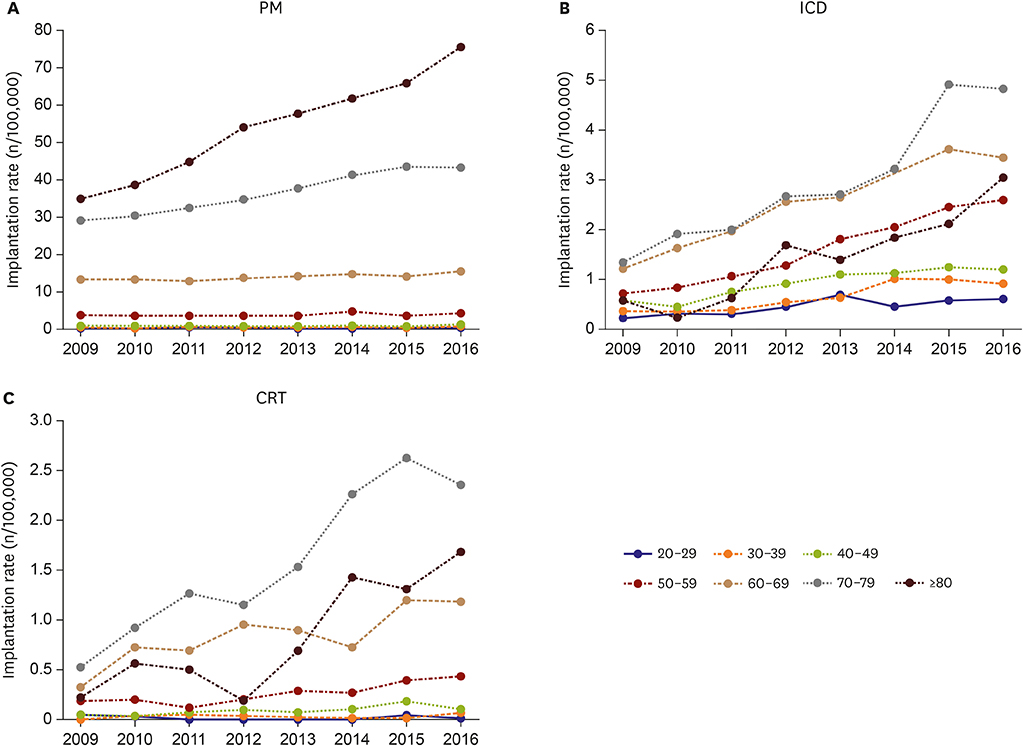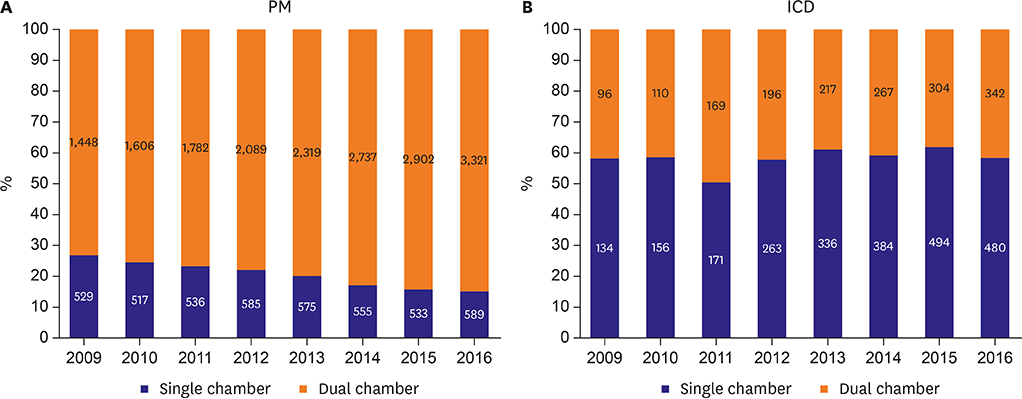Korean Circ J.
2019 Sep;49(9):841-852. 10.4070/kcj.2018.0444.
Temporal Trends of Cardiac Implantable Electronic Device Implantations: a Nationwide Population-based Study
- Affiliations
-
- 1Department of Cardiology, Cardiovascular Center, Seoul National University Bundang Hospital, Seongnam, Korea.
- 2Department of Internal Medicine, Seoul National University Hospital, Seoul, Korea. choiek17@snu.ac.kr
- 3Medtronic Korea, Ltd., Seoul, Korea.
- 4Graduate School for Medical Device Management and Research, Samsung Advanced Institute for Health Science and Technology, Sungkyunkwan University, Seoul, Korea.
- KMID: 2455790
- DOI: http://doi.org/10.4070/kcj.2018.0444
Abstract
- BACKGROUND AND OBJECTIVES
Implantation of cardiac implantable electronic devices (CIED), including permanent pacemakers (PM), implantable cardioverter-defibrillators (ICD), and cardiac resynchronization therapy (CRT) devices, has increased significantly over the past several years. However, limited data exists regarding temporal trends of CIED implantations in Asian population. This study aimed to investigate temporal trends of CIED treatment in Korea.
METHODS
Using the National Health Insurance Service database of the entire Korean adult population, temporal trends of CIED procedures between 2009 and 2016 were evaluated. Additionally, temporal changes in the prevalence of patients' comorbidities were evaluated.
RESULTS
A total of 35,421 CIED procedures (new implantations: 27,771, replacements: 7,650) were performed during the study period. The mean age of new CIED recipients and the prevalence of comorbidities, including hypertension, diabetes mellitus, heart failure, stroke, and atrial fibrillation, increased substantially with time. Compared to 2009, the number of new implantations of PM, ICD, and CRT devices increased by 2.0 (1,977 to 3,910), 3.6 (230 to 822), and 4.9 (44 to 217) times in 2016, respectively. The annual new implantation rate of CIED also increased accordingly (5.1 to 9.3 for PM, 0.6 to 1.9 for ICD, and 0.1 to 0.5 for CRT devices, per 100,000 persons).
CONCLUSIONS
The number of CIED implantation increased substantially from 2009 to 2016 in Korea. Also, the patients with CIED have been changed to be older and have more comorbidities. Therefore, the burden of health care cost in patients with CIED would be expected to increase in the future.
MeSH Terms
Figure
Cited by 2 articles
-
Finding Cardiac Resynchronization Therapy Responders: Postprocedural QRS-T Morphologies Matter
Min Kim, Tae-Hoon Kim
Korean Circ J. 2020;50(12):1074-1076. doi: 10.4070/kcj.2020.0434.Cardiac Implantable Electronic Device Therapy in Korea: Increasing but Still Quite Low
Myung Hwan Bae
Korean Circ J. 2019;49(9):853-855. doi: 10.4070/kcj.2019.0131.
Reference
-
1. Levine PA, Stanton MS, Sims JJ. High quality performance of pacemakers and implantable defibrillators. Pacing Clin Electrophysiol. 2002; 25:1667–1669.
Article2. Epstein AE, DiMarco JP, Ellenbogen KA, et al. 2012 ACCF/AHA/HRS focused update incorporated into the ACCF/AHA/HRS 2008 guidelines for device-based therapy of cardiac rhythm abnormalities: a report of the American College of Cardiology Foundation/American Heart Association Task Force on Practice Guidelines and the Heart Rhythm Society. J Am Coll Cardiol. 2013; 61:e6–e75.3. Brignole M, Auricchio A, Baron-Esquivias G, et al. 2013 ESC Guidelines on cardiac pacing and cardiac resynchronization therapy: the task force on cardiac pacing and resynchronization therapy of the European Society of Cardiology (ESC). Developed in collaboration with the European Heart Rhythm Association (EHRA). Eur Heart J. 2013; 34:2281–2329.4. Priori SG, Blomström-Lundqvist C, Mazzanti A, et al. 2015 ESC Guidelines for the management of patients with ventricular arrhythmias and the prevention of sudden cardiac death: the task force for the management of patients with ventricular arrhythmias and the prevention of sudden cardiac death of the European Society of Cardiology (ESC). Endorsed by: Association for European Paediatric and Congenital Cardiology (AEPC). Eur Heart J. 2015; 36:2793–2867.5. Mond HG, Irwin M, Ector H, Proclemer A. The world survey of cardiac pacing and cardioverter-defibrillators: calendar year 2005 an International Cardiac Pacing and Electrophysiology Society (ICPES) project. Pacing Clin Electrophysiol. 2008; 31:1202–1212.6. Uslan DZ, Tleyjeh IM, Baddour LM, et al. Temporal trends in permanent pacemaker implantation: a population-based study. Am Heart J. 2008; 155:896–903.
Article7. Kurtz SM, Ochoa JA, Lau E, et al. Implantation trends and patient profiles for pacemakers and implantable cardioverter defibrillators in the United States: 1993-2006. Pacing Clin Electrophysiol. 2010; 33:705–711.
Article8. Greenspon AJ, Patel JD, Lau E, et al. Trends in permanent pacemaker implantation in the United States from 1993 to 2009: increasing complexity of patients and procedures. J Am Coll Cardiol. 2012; 60:1540–1545.9. Greenspon AJ, Patel JD, Lau E, et al. 16-Year trends in the infection burden for pacemakers and implantable cardioverter-defibrillators in the United States 1993 to 2008. J Am Coll Cardiol. 2011; 58:1001–1006.10. Udo EO, van Hemel NM, Zuithoff NP, Doevendans PA, Moons KG. Prognosis of the bradycardia pacemaker recipient assessed at first implantation: a nationwide cohort study. Heart. 2013; 99:1573–1578.
Article11. Brunner M, Olschewski M, Geibel A, Bode C, Zehender M. Long-term survival after pacemaker implantation. Prognostic importance of gender and baseline patient characteristics. Eur Heart J. 2004; 25:88–95.
Article12. Hyun KR, Kang S, Lee S. Population aging and healthcare expenditure in Korea. Health Econ. 2016; 25:1239–1251.
Article13. Raatikainen MJ, Arnar DO, Zeppenfeld K, Merino JL, Kuck KH, Hindricks G. Current trends in the use of cardiac implantable electronic devices and interventional electrophysiological procedures in the European Society of Cardiology member countries: 2015 report from the European Heart Rhythm Association. Europace. 2015; 17:Suppl 4. iv1–iv72.
Article14. Mond HG, Proclemer A. The 11th world survey of cardiac pacing and implantable cardioverter-defibrillators: calendar year 2009--a World Society of Arrhythmia's project. Pacing Clin Electrophysiol. 2011; 34:1013–1027.
Article15. Moss AJ, Hall WJ, Cannom DS, et al. Cardiac-resynchronization therapy for the prevention of heart-failure events. N Engl J Med. 2009; 361:1329–1338.
Article16. Moss AJ, Zareba W, Hall WJ, et al. Prophylactic implantation of a defibrillator in patients with myocardial infarction and reduced ejection fraction. N Engl J Med. 2002; 346:877–883.
Article17. Castellanos JM, Smith LM, Varosy PD, Dehlendorf C, Marcus GM. Referring physicians' discordance with the primary prevention implantable cardioverter-defibrillator guidelines: a national survey. Heart Rhythm. 2012; 9:874–881.
Article18. Al-Khatib SM, Stevenson WG, Ackerman MJ, et al. 2017 AHA/ACC/HRS guideline for management of patients with ventricular arrhythmias and the prevention of sudden cardiac death: a report of the American College of Cardiology/American Heart Association Task Force on Clinical Practice Guidelines and the Heart Rhythm Society. J Am Coll Cardiol. 2018; 72:e91–e220.19. Yancy CW, Jessup M, Bozkurt B, et al. 2017 ACC/AHA/HFSA focused update of the 2013 ACCF/AHA guideline for the management of heart failure: a report of the American College of Cardiology/American Heart Association Task Force on Clinical Practice Guidelines and the Heart Failure Society of America. J Am Coll Cardiol. 2017; 70:776–803.20. Ponikowski P, Voors AA, Anker SD, et al. 2016 ESC Guidelines for the diagnosis and treatment of acute and chronic heart failure: the task force for the diagnosis and treatment of acute and chronic heart failure of the European Society of Cardiology (ESC). Developed with the special contribution of the Heart Failure Association (HFA) of the ESC. Eur J Heart Fail. 2016; 18:891–975.21. Curtis AB, Yancy CW, Albert NM, et al. Cardiac resynchronization therapy utilization for heart failure: findings from IMPROVE HF. Am Heart J. 2009; 158:956–964.
Article22. Mehra MR, Yancy CW, Albert NM, et al. Evidence of clinical practice heterogeneity in the use of implantable cardioverter-defibrillators in heart failure and post-myocardial infarction left ventricular dysfunction: findings from IMPROVE HF. Heart Rhythm. 2009; 6:1727–1734.
Article23. Hübinette C, Lund LH, Gadler F, Ståhlberg M. Awareness of indications for device therapy among a broad range of physicians: a survey study. Europace. 2014; 16:1580–1586.
Article24. Satake H, Fukuda K, Sakata Y, et al. Current status of primary prevention of sudden cardiac death with implantable cardioverter defibrillator in patients with chronic heart failure--a report from the CHART-2 Study. Circ J. 2015; 79:381–390.25. Lee H, Oh SH, Cho H, Cho HJ, Kang HY. Prevalence and socio-economic burden of heart failure in an aging society of South Korea. BMC Cardiovasc Disord. 2016; 16:215.
Article26. Konishi M, Ishida J, Springer J, et al. Heart failure epidemiology and novel treatments in Japan: facts and numbers. ESC Heart Fail. 2016; 3:145–151.
Article27. Kim J, Choi EK, Lee MH, et al. The relevance of the primary prevention criteria for implantable cardioverter defibrillator implantation in korean symptomatic severe heart failure patients. Korean Circ J. 2012; 42:173–183.
Article28. Zeitler EP, Sanders GD, Singh K, et al. Single vs. dual chamber implantable cardioverter-defibrillators or programming of implantable cardioverter-defibrillators in patients without a bradycardia pacing indication: systematic review and meta-analysis. Europace. 2018; 20:1621–1629.
Article29. Peterson PN, Greenlee RT, Go AS, et al. Comparison of inappropriate shocks and other health outcomes between single- and dual-chamber implantable cardioverter-defibrillators for primary prevention of sudden cardiac death: results from the cardiovascular research network longitudinal study of implantable cardioverter-defibrillators. J Am Heart Assoc. 2017; 6:e006937.
Article30. Hu ZY, Zhang J, Xu ZT, et al. Efficiencies and complications of dual chamber versus single chamber implantable cardioverter defibrillators in secondary sudden cardiac death prevention: a meta-analysis. Heart Lung Circ. 2016; 25:148–154.
Article31. Defaye P, Boveda S, Klug D, et al. Dual- vs. single-chamber defibrillators for primary prevention of sudden cardiac death: long-term follow-up of the Défibrillateur Automatique Implantable-Prévention Primaire registry. Europace. 2017; 19:1478–1484.
Article32. Lubinski A, Bissinger A, Boersma L, et al. Determinants of geographic variations in implantation of cardiac defibrillators in the European Society of Cardiology member countries--data from the European Heart Rhythm Association White Book. Europace. 2011; 13:654–662.
Article33. Lee SH, Park SJ, Kim JS, Shin DH, Cho DK, On YK. Mid-term outcomes in patients implanted with cardiac resynchronization therapy. J Korean Med Sci. 2014; 29:1651–1657.
Article34. Uhm JS, Oh J, Cho IJ, et al. Left ventricular end-systolic volume can predict 1-year hierarchical clinical composite end point in patients with cardiac resynchronization therapy. Yonsei Med J. 2019; 60:48–55.
Article35. Hatfield LA, Kramer DB, Volya R, Reynolds MR, Normand SL. Geographic and temporal variation in cardiac implanted electric devices to treat heart failure. J Am Heart Assoc. 2016; 5:e003532.
Article36. Bristow MR, Saxon LA, Boehmer J, et al. Cardiac-resynchronization therapy with or without an implantable defibrillator in advanced chronic heart failure. N Engl J Med. 2004; 350:2140–2150.
Article
- Full Text Links
- Actions
-
Cited
- CITED
-
- Close
- Share
- Similar articles
-
- Reposition of Cardiac Implantable Electronic Devices Using Pectoralis Major Muscle Pocket
- Hematoma Prevention Using Tachosil (Fibrin Sealant) Patch during Insertion of Cardiovascular Implantable Electronic Devices without Suspending Antithrombotics: Three Case Reports
- Superior Vena Cava Echocardiography as a Screening Tool to Predict Cardiovascular Implantable Electronic Device Lead Fibrosis
- Combined Subpectoral Implantation of Implantable Cardioverter-Defibrillator and Augmentation Mammoplasty in a Young Female Patient
- Cardiac Implantable Electronic Device Safety during Magnetic Resonance Imaging




